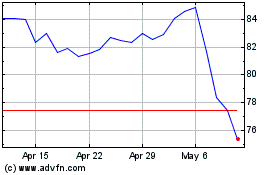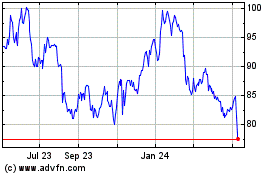Sony Re-Commits to Roots With Return to Robotics
June 30 2016 - 1:10PM
Dow Jones News
TOKYO—Sony Corp.'s return to robotics, a step announced this
week along with a bullish profit outlook, reflects a commitment to
its roots as a consumer-electronics giant, Chief Executive Kazuo
Hirai said.
Mr. Hirai, who spent much of his early tenure streamlining the
company's troubled portfolio, said on Thursday that it was time to
start taking steps toward a more-ambitious future, and robotics
will be part of that journey.
"We need to push the envelope to really grow Sony into other
parts in all of the electronics business, where we know we could
make a difference," Mr. Hirai told The Wall Street Journal in an
interview.
Sony, which started as a hardware maker, has evolved into a
conglomerate that includes units in fields such as financial and
network services. But hardware will remain a core business because
devices will always be needed regardless of how the internet space
evolves, Mr. Hirai said.
"You can have all these great services, content, but there is a
device you need to enjoy it, or actually to feed information to the
network," he said.
Sony's re-entry into the robotics field wasn't as widely
heralded by analysts as its announcement Wednesday that it was on
track to achieve an operating profit of ¥ 500 billion ($4.86
billion) for the year ending March 2018. The 70-year-old company,
which returned to profitability only in the previous fiscal year
ended in March, has achieved that level of operating profit only
once before, in fiscal 1997.
Still, many analysts say the target is at the low end of their
expected range, despite a slowing global economy and concerns about
fallout from the U.K.'s vote to leave the European Union.
A slowdown in sales of Apple's iPhone has hit Sony by curbing
demand for its image sensors, which are used in the phone's camera.
Because of its diversified portfolio and geographic range, Sony is
one of the few companies targeting consumers directly that can keep
growing despite the headwinds, said SMBC Nikko Securities Ryosuke
Katsura.
Videogames are a bright spot. Sony's flagship PlayStation 4
console has sold more than 40 million units since its introduction
in November 2013, surpassing rivals such as Xbox One from Microsoft
Corp. and Wii U from Nintendo Co. Membership in its fee-based
subscription service, called PlayStation Plus, increased to 20.8
million in March of this year from 10.9 million in January
2015.
As of the end of trading Thursday, Sony's share had risen 10%
this week.
Sony was among the first companies to develop robots for
consumers, launching the dog-like Aibo in 1999. It left the market
in 2006 as a part of decision to restructure, and since then others
have jumped in, including SoftBank Group Corp. with Pepper. But no
one has taken robots mainstream.
Mr. Hirai said he was confident Sony can differentiate itself in
the market, just as it did more than 20 years ago with video games,
at the time ruled by Nintendo. Sony's PlayStation business has
grown to be the major growth driver for the group.
Mr. Hirai declined to outline the company's robotics strategy in
detail, but said one theme is "recurring," or designing a model
that brings customers back for periodical purchases. The strategy
has already proved successful in its PlayStation and Alpha digital
camera businesses.
Many companies already in the robotics industry have taken a
similar approach. Sharp Corp.'s Robohon, a robot that also works as
a smartphone, requires users to pay monthly fees in exchange for
software updates and add-ons. But none have had a huge hit yet,
with robots remaining expensive and less than personable.
Mr. Hirai said he is willing to nurture the business by offering
a range of products for consumers and companies, and could set up a
separate unit for each.
Atsushi Osanai, a professor at Waseda Business School and former
Sony employee, said it was too early to evaluate Sony's prospects
in robotics. But the decision to embark on the challenge indicates
Sony is charting a complete comeback because the company's strategy
is to choose only industries in which it believes it can
differentiate itself, regardless of market size.
"It is a welcoming move that Sony has made this shift," he said.
"We could see Sony with a bunch of innovative products and great
ideas once again in the near future."
(END) Dow Jones Newswires
June 30, 2016 12:55 ET (16:55 GMT)
Copyright (c) 2016 Dow Jones & Company, Inc.
Sony (NYSE:SONY)
Historical Stock Chart
From Mar 2024 to Apr 2024

Sony (NYSE:SONY)
Historical Stock Chart
From Apr 2023 to Apr 2024
